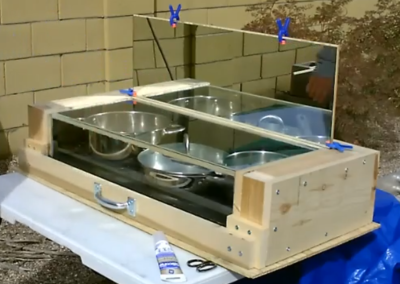SENIORS CLIMATE ACTION NETWORK (SCAN)
City Prepping
Introduction
City Prepping ensures resilience during an emergency disruption in supply chains. With our current economic system, we are locked into a just-in-time supply chain and distribution system which is inherently risky. If there should be long term disruptions to our food, water, fuel, and electricity supplies, then by preparing in advance for such disruptions, we can ensure our own continued supply of food and potable water, means of keeping warm, transport, lighting, and access to communication lines. All the following City Prepping items can be purchased in New Zealand.
Shelter
Use of your shelter can be lost due to landslides, flooding, and earthquakes. In these situations, the best preparation in advance is to keep together all the items you would need for a tramping trip at short notice – food, water, warm clothing, temporary shelter (tent & sleeping bags), cooking facilities, mobile and radio, LED battery operated torch, and a medical kit. Don’t forget any medications.
If you haven’t lost the use of your home during a disruption in supply chains of energy, food, and water, then you are best to simply stay living in your home.
If you live in a high-rise apartment building which necessitates the use of a lift especially for the infirm, then it is essential that your building has a backup generator. Long term disruptions of fuel for generators would be a major problem.
Keeping Warm
Additional layers of clothing are an efficient way to keep warm should you rely on electricity or gas to heat your home. If you live in a country such as New Zealand where the seasonal climate is moderate and winters are not severe, then you can keep warm inside your home or temporary shelter by adding layers of clothing. Outdoor insulated coveralls is an inexpensive way of providing additional clothing insulation. Antarctic type coveralls would be needed during severe winters.
City Prepping ensures resilience during an emergency disruption in supply chains. With our current economic system, we are locked into a just-in-time supply chain and distribution system which is inherently risky. If there should be long term disruptions to our food, water, fuel, and electricity supplies, then by preparing in advance for such disruptions, we can ensure our own continued supply of food and potable water, means of keeping warm, transport, lighting, and access to communication lines. All the following City Prepping items can be purchased in New Zealand.
Shelter
Use of your shelter can be lost due to landslides, flooding, and earthquakes. In these situations, the best preparation in advance is to keep together all the items you would need for a tramping trip at short notice – food, water, warm clothing, temporary shelter (tent & sleeping bags), cooking facilities, mobile and radio, LED battery operated torch, and a medical kit. Don’t forget any medications.
If you haven’t lost the use of your home during a disruption in supply chains of energy, food, and water, then you are best to simply stay living in your home.
If you live in a high-rise apartment building which necessitates the use of a lift especially for the infirm, then it is essential that your building has a backup generator. Long term disruptions of fuel for generators would be a major problem.
Keeping Warm
Additional layers of clothing are an efficient way to keep warm should you rely on electricity or gas to heat your home. If you live in a country such as New Zealand where the seasonal climate is moderate and winters are not severe, then you can keep warm inside your home or temporary shelter by adding layers of clothing. Outdoor insulated coveralls is an inexpensive way of providing additional clothing insulation. Antarctic type coveralls would be needed during severe winters.

Food
Food in the medium term (1 month) is taken care of by stock piling non-refrigerated items which you normally use. Stock up with non-essential food items to ensure variety in your diet. A supply of salt is essential.
If you do not have access to cooking with a flame on a stove or outdoors (a porch or balcony, for example), then you should store a stock of food accordingly. For example, cooked porridge for breakfast can be replaced by processed cereals.
Food supply is a problem in the long term if you don't have a veggie garden. If you are unable to have a veggie garden at home, then consider joining a local Community Garden.
Food which contains the most carbohydrates and nutrition in the smallest volume of space and which have the longest shelf life are the grains before milling and rice. Brown rice can go rancid after 6 months, whereas white rice has a shelf life of a few years when stored in airtight containers. Wheat grain lasts for years in appropriate storage. Dry ice can be used to evacuate air from a container before closing the lid and sealing it tight with duct tape. Caution is needed when handling dry ice. Follow the advice.
A Victoria Corn Mill made in Corona can be purchased for under NZ $200. Three cups of whole wheat grain mills out into 4 cups of 100% wholemeal flour. The dough of 100% wholemeal flour doesn’t rise very much, but the resulting bread has some spring and is very tasty. Use of a flour sieve will increase the proportion of white flour gluten content which will rise much more.
Food in the medium term (1 month) is taken care of by stock piling non-refrigerated items which you normally use. Stock up with non-essential food items to ensure variety in your diet. A supply of salt is essential.
If you do not have access to cooking with a flame on a stove or outdoors (a porch or balcony, for example), then you should store a stock of food accordingly. For example, cooked porridge for breakfast can be replaced by processed cereals.
Food supply is a problem in the long term if you don't have a veggie garden. If you are unable to have a veggie garden at home, then consider joining a local Community Garden.
Food which contains the most carbohydrates and nutrition in the smallest volume of space and which have the longest shelf life are the grains before milling and rice. Brown rice can go rancid after 6 months, whereas white rice has a shelf life of a few years when stored in airtight containers. Wheat grain lasts for years in appropriate storage. Dry ice can be used to evacuate air from a container before closing the lid and sealing it tight with duct tape. Caution is needed when handling dry ice. Follow the advice.
A Victoria Corn Mill made in Corona can be purchased for under NZ $200. Three cups of whole wheat grain mills out into 4 cups of 100% wholemeal flour. The dough of 100% wholemeal flour doesn’t rise very much, but the resulting bread has some spring and is very tasty. Use of a flour sieve will increase the proportion of white flour gluten content which will rise much more.
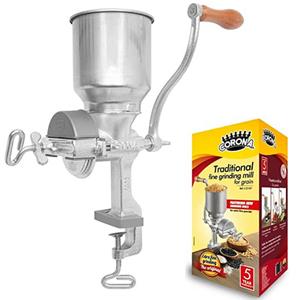
Ground brown or white rice flour cannot make rising dough, but one can make tortillas on a skillet using ground rice flour and water.
Porridge is commercially made from rolled oats. Oat grain can be hand rolled using a manual roller with hopper for under NZ $250.
Porridge is commercially made from rolled oats. Oat grain can be hand rolled using a manual roller with hopper for under NZ $250.
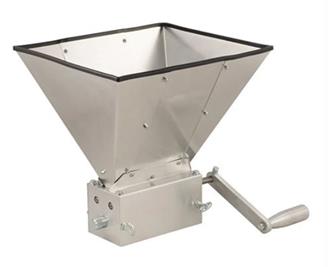
Winnowing of the chaff can be accomplished using a winnowing mat in a breeze. The result will be groats which can be cooked for breakfast.
Potable Water
We all need a minimum of 2 litres of drinking water per day. For a family of 4 over 30 days, this equates to 240 litres, A 250-litre water tank complete with water collector/diverter from your roof spouting and hose and fittings can be purchased for under NZ $250.
Potable Water
We all need a minimum of 2 litres of drinking water per day. For a family of 4 over 30 days, this equates to 240 litres, A 250-litre water tank complete with water collector/diverter from your roof spouting and hose and fittings can be purchased for under NZ $250.

Long term storage of water can be sterilised by using sodium hypochlorite in liquid form. This approach is much less expensive than using sterilisation tablets. A guide on how much to use can be downloaded from the New Zealand Community & Public Health website.
Boiling Water
A 1.6 litre stainless steel Kelly Kettle from the UK can be purchased for under NZ $200. This kettle works on the same principle as the New Zealand manufactured Thermette Kettle which sells for about the same price delivered, except the Kelly Kettle is a better-quality constructed kettle. The copper Thermette Kettle is expensive. All these kettles are far more efficient at boiling water than boiling water over a fire in a container. It is possible to boil 1.6 litres of water in a Kelly Kettle within a few minutes from starting a fire using kindling.
Boiling Water
A 1.6 litre stainless steel Kelly Kettle from the UK can be purchased for under NZ $200. This kettle works on the same principle as the New Zealand manufactured Thermette Kettle which sells for about the same price delivered, except the Kelly Kettle is a better-quality constructed kettle. The copper Thermette Kettle is expensive. All these kettles are far more efficient at boiling water than boiling water over a fire in a container. It is possible to boil 1.6 litres of water in a Kelly Kettle within a few minutes from starting a fire using kindling.

It is not good practice to boil water in cast iron containers because doing so removes the vegetable oil baked on patina which protects against rusting.
Cooking in a pot using a Rocket Stove
A Rocket or Falcon Stove which uses kindling is ideal for cooking in a pot and can be purchased for under NZ $250 from Challenge Yachts Ltd.
Cooking in a pot using a Rocket Stove
A Rocket or Falcon Stove which uses kindling is ideal for cooking in a pot and can be purchased for under NZ $250 from Challenge Yachts Ltd.
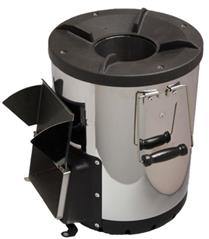
Baking in a Coleman Oven on top of a Rocket Stove
Baking can be done in a cast iron Dutch oven using an open camp fire, but control of the temperature is hairy. A Coleman oven is a far better approach than using a Dutch oven for baking and can be purchased for under NZ $150. A Rocket Stove can be used as a source of heat.
Baking can be done in a cast iron Dutch oven using an open camp fire, but control of the temperature is hairy. A Coleman oven is a far better approach than using a Dutch oven for baking and can be purchased for under NZ $150. A Rocket Stove can be used as a source of heat.
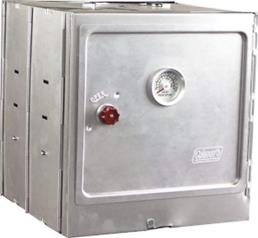
Place two bricks inside the bottom of the oven to ensure consistent heat. The Coleman oven can heat up to 230° C within 20 minutes of firing up the rocket stove.
The Coleman oven can collapse into 300 mm x 300 mm x 75 mm size for storage using an elegant concertina design. However, the Coleman oven isn't designed to lift and carry 2 bricks on the bottom of the oven using the handle at the top of the oven. A solution is to pop riveted the sides of the oven together into a permanent cube configuration.
Although the Coleman oven has a thermometer built into the front door, additional thermometers are needed to establish and maintain an ideal interior temperature for baking. Use an additional probing thermometer placed into the vent at the exterior top of the oven and an interior thermometer placed inside the empty oven. Compare the probing thermometer temperature against the interior temperature which will drop after you open the door. From then onwards, maintain the required temperature inside the oven by monitoring the exterior probing thermometer and adding kindling when necessary. It doesn’t take much additional kindling to maintain the required baking temperature. Each probe and interior thermometer costs about NZ $20.
The Coleman oven can collapse into 300 mm x 300 mm x 75 mm size for storage using an elegant concertina design. However, the Coleman oven isn't designed to lift and carry 2 bricks on the bottom of the oven using the handle at the top of the oven. A solution is to pop riveted the sides of the oven together into a permanent cube configuration.
Although the Coleman oven has a thermometer built into the front door, additional thermometers are needed to establish and maintain an ideal interior temperature for baking. Use an additional probing thermometer placed into the vent at the exterior top of the oven and an interior thermometer placed inside the empty oven. Compare the probing thermometer temperature against the interior temperature which will drop after you open the door. From then onwards, maintain the required temperature inside the oven by monitoring the exterior probing thermometer and adding kindling when necessary. It doesn’t take much additional kindling to maintain the required baking temperature. Each probe and interior thermometer costs about NZ $20.

Transport
Bikes are an excellent solution to a medium or long term disruption to fuel supplies for cars. Three-wheel trikes are available for those whose balance is unsteady on a standard two-wheeler bike. Trikes also provide greater flexibility than two wheelers to carry a load on the back to transport provisions etc.
Bikes are an excellent solution to a medium or long term disruption to fuel supplies for cars. Three-wheel trikes are available for those whose balance is unsteady on a standard two-wheeler bike. Trikes also provide greater flexibility than two wheelers to carry a load on the back to transport provisions etc.
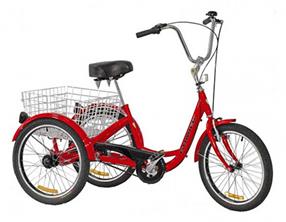
There were many more bikes on the road in New Zealand during the COVID lockdown when use of cars was restricted. Families with very young children on bikes made good use of the roads during lockdown. Some people are critical of cycleways in New Zealand because there are currently few bikes which make use of cycleways compared to the number of people who used bikes 50 years ago. School bike sheds were then full of bikes. It is a chicken and egg situation. Many people simply do not want to share the road with cars. There are very few cycleways adjacent to city and town roads in New Zealand which provide physical separation between cars and bikes. The physical separation between cars and bikes South bound along Cumberland Street in Dunedin is commendable, but doesn't go far enough. The North bound cycleway along Crawford Street does not provide physical separation. Priority is still given to space for parking for cars which could be used to establish a physical boundary between cars and bikes.
Communications
During a disruption to the supply of electricity, you can continue using a tablet and laptop and recharge your mobile phone and emergency portable LED lights by using a Solar Laptop Charger with a small 150mm x 100 mm photovoltaic panel. This device can be purchased for under NZ $150. An ideal specification for a Solar Laptop Charger is as follows:
Battery Type: Li-Polymer Battery
Capacity: 23000 mAh/85Wh
Input: DC 14-20C 1,2A
Solar Charger: 15V 150 mA
Output: DC 12V/16V/19V 3A USB 5V/2.1 A
The above device can recharge a mobile a several times without becoming fully discharged. An additional 100-watt photovoltaic panel (about 0.5 square metres) costing under NZ $200 can be used to speed up recharging the device.
A laptop runs at about 85 watts or less and it is possible to plug a photovoltaic panel directly into a laptop if the output DC voltage is correct for your laptop. However, it is safer to charge up the Solar Laptop Charger first because it has inbuilt safety features and then use the Solar Laptop Charger to power up or recharge the laptop.
An additional connection cable from the 100-watt photovoltaic panel to the Solar Laptop Charger can be purchased for under $25 and an input plug to match the Solar Laptop Charger will cost under NZ $5.
A battery-operated FM/AM radio is essential for staying in touch with news should mobile communication towers be down.
Additional Information
New Zealand Government website "Work out what supplies you need: - link here
“City Prepping: Helping City Dwellers Learn the Basics of Survival in Times of Crisis” - YouTube Series link here
Communications
During a disruption to the supply of electricity, you can continue using a tablet and laptop and recharge your mobile phone and emergency portable LED lights by using a Solar Laptop Charger with a small 150mm x 100 mm photovoltaic panel. This device can be purchased for under NZ $150. An ideal specification for a Solar Laptop Charger is as follows:
Battery Type: Li-Polymer Battery
Capacity: 23000 mAh/85Wh
Input: DC 14-20C 1,2A
Solar Charger: 15V 150 mA
Output: DC 12V/16V/19V 3A USB 5V/2.1 A
The above device can recharge a mobile a several times without becoming fully discharged. An additional 100-watt photovoltaic panel (about 0.5 square metres) costing under NZ $200 can be used to speed up recharging the device.
A laptop runs at about 85 watts or less and it is possible to plug a photovoltaic panel directly into a laptop if the output DC voltage is correct for your laptop. However, it is safer to charge up the Solar Laptop Charger first because it has inbuilt safety features and then use the Solar Laptop Charger to power up or recharge the laptop.
An additional connection cable from the 100-watt photovoltaic panel to the Solar Laptop Charger can be purchased for under $25 and an input plug to match the Solar Laptop Charger will cost under NZ $5.
A battery-operated FM/AM radio is essential for staying in touch with news should mobile communication towers be down.
Additional Information
New Zealand Government website "Work out what supplies you need: - link here
“City Prepping: Helping City Dwellers Learn the Basics of Survival in Times of Crisis” - YouTube Series link here
Cooking, baking, frying, and grilling using solar energy
Food can be cooked, baked, or even fried and grilled by reflecting the heat energy of the sun onto the food. Flat reflectors redirect the rays of the sun for cooking and baking while parabolic reflectors focus the rays of the sun for frying or grilling. Reflectors can be mirrors or shiny surfaces and an insulated box with reflectors can be used to maintain higher temperatures. The downside of solar cooking is that you need a sunny day and cooking takes longer. Preheating can be done by placing the empty oven facing the sun while you prepare your food. On a sunny day, the pans and oven will be very warm within 15 to 30 minutes. Food can then be added to the pots and the cooking process will begin more quickly.
Parabolic reflectors can be expensive, though the SunGood portable solar parabolic mirrors panel cooker designed and manufactured by Solar Brother is relatively inexpensive at NZ $229 available at Solar Ovens New Zealand.
Food can be cooked, baked, or even fried and grilled by reflecting the heat energy of the sun onto the food. Flat reflectors redirect the rays of the sun for cooking and baking while parabolic reflectors focus the rays of the sun for frying or grilling. Reflectors can be mirrors or shiny surfaces and an insulated box with reflectors can be used to maintain higher temperatures. The downside of solar cooking is that you need a sunny day and cooking takes longer. Preheating can be done by placing the empty oven facing the sun while you prepare your food. On a sunny day, the pans and oven will be very warm within 15 to 30 minutes. Food can then be added to the pots and the cooking process will begin more quickly.
Parabolic reflectors can be expensive, though the SunGood portable solar parabolic mirrors panel cooker designed and manufactured by Solar Brother is relatively inexpensive at NZ $229 available at Solar Ovens New Zealand.


The smaller solar box oven supplied by Solar Ovens New Zealand costs $1,349.
Genesis energy provides a school project guide to constructing an inexpensive solar box oven using a pizza box and there are a large number of YouTube videos on how to construct similar solar box ovens – sample link here.
The following YouTube video demonstrates how to construct your own highly efficient solar box oven – link here
The following YouTube video demonstrates how to construct your own highly efficient solar box oven – link here
